Financial Analysis of AGL: Impairment Testing and Reporting
VerifiedAdded on 2021/06/17
|7
|1571
|53
Report
AI Summary
This report provides a comprehensive analysis of AGL's impairment testing practices, focusing on the application of accounting principles to assess the value of assets. It examines the concept of impairment, the methods used for valuation (fair value less costs of disposal and value in use), and th...
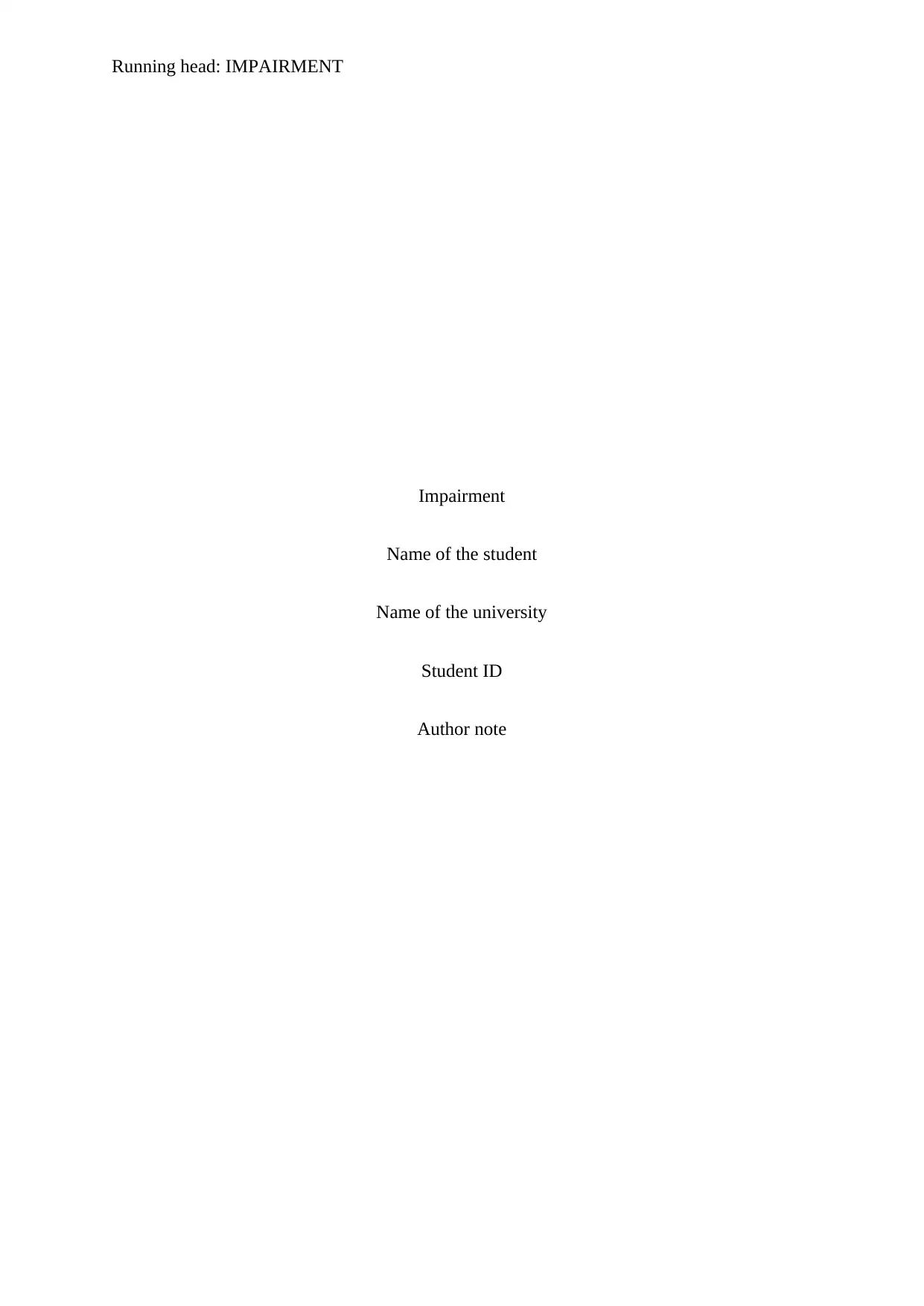
Running head: IMPAIRMENT
Impairment
Name of the student
Name of the university
Student ID
Author note
Impairment
Name of the student
Name of the university
Student ID
Author note
Paraphrase This Document
Need a fresh take? Get an instant paraphrase of this document with our AI Paraphraser
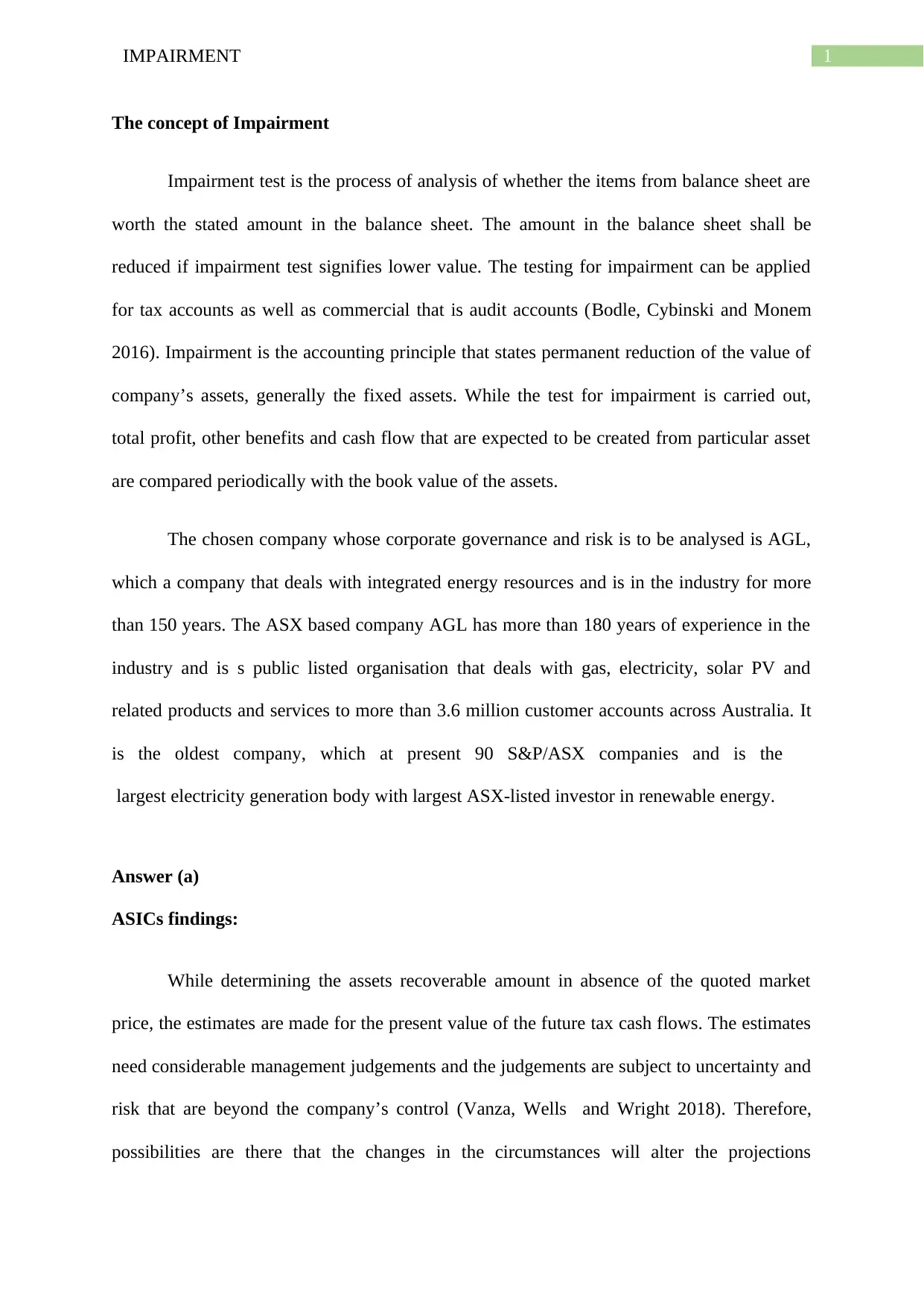
1IMPAIRMENT
The concept of Impairment
Impairment test is the process of analysis of whether the items from balance sheet are
worth the stated amount in the balance sheet. The amount in the balance sheet shall be
reduced if impairment test signifies lower value. The testing for impairment can be applied
for tax accounts as well as commercial that is audit accounts (Bodle, Cybinski and Monem
2016). Impairment is the accounting principle that states permanent reduction of the value of
company’s assets, generally the fixed assets. While the test for impairment is carried out,
total profit, other benefits and cash flow that are expected to be created from particular asset
are compared periodically with the book value of the assets.
The chosen company whose corporate governance and risk is to be analysed is AGL,
which a company that deals with integrated energy resources and is in the industry for more
than 150 years. The ASX based company AGL has more than 180 years of experience in the
industry and is s public listed organisation that deals with gas, electricity, solar PV and
related products and services to more than 3.6 million customer accounts across Australia. It
is the oldest company, which at present 90 S&P/ASX companies and is the
largest electricity generation body with largest ASX-listed investor in renewable energy.
Answer (a)
ASICs findings:
While determining the assets recoverable amount in absence of the quoted market
price, the estimates are made for the present value of the future tax cash flows. The estimates
need considerable management judgements and the judgements are subject to uncertainty and
risk that are beyond the company’s control (Vanza, Wells and Wright 2018). Therefore,
possibilities are there that the changes in the circumstances will alter the projections
The concept of Impairment
Impairment test is the process of analysis of whether the items from balance sheet are
worth the stated amount in the balance sheet. The amount in the balance sheet shall be
reduced if impairment test signifies lower value. The testing for impairment can be applied
for tax accounts as well as commercial that is audit accounts (Bodle, Cybinski and Monem
2016). Impairment is the accounting principle that states permanent reduction of the value of
company’s assets, generally the fixed assets. While the test for impairment is carried out,
total profit, other benefits and cash flow that are expected to be created from particular asset
are compared periodically with the book value of the assets.
The chosen company whose corporate governance and risk is to be analysed is AGL,
which a company that deals with integrated energy resources and is in the industry for more
than 150 years. The ASX based company AGL has more than 180 years of experience in the
industry and is s public listed organisation that deals with gas, electricity, solar PV and
related products and services to more than 3.6 million customer accounts across Australia. It
is the oldest company, which at present 90 S&P/ASX companies and is the
largest electricity generation body with largest ASX-listed investor in renewable energy.
Answer (a)
ASICs findings:
While determining the assets recoverable amount in absence of the quoted market
price, the estimates are made for the present value of the future tax cash flows. The estimates
need considerable management judgements and the judgements are subject to uncertainty and
risk that are beyond the company’s control (Vanza, Wells and Wright 2018). Therefore,
possibilities are there that the changes in the circumstances will alter the projections
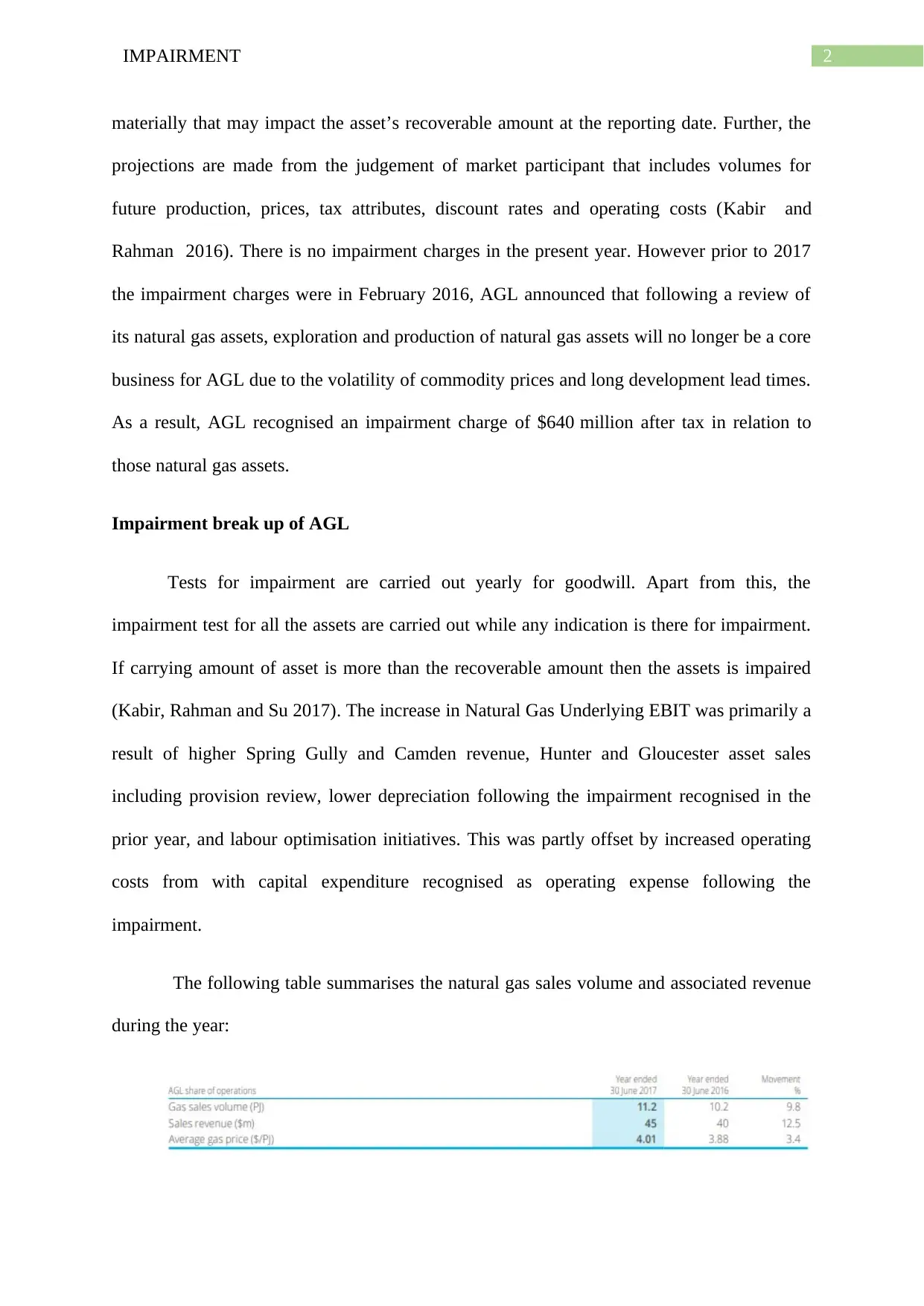
2IMPAIRMENT
materially that may impact the asset’s recoverable amount at the reporting date. Further, the
projections are made from the judgement of market participant that includes volumes for
future production, prices, tax attributes, discount rates and operating costs (Kabir and
Rahman 2016). There is no impairment charges in the present year. However prior to 2017
the impairment charges were in February 2016, AGL announced that following a review of
its natural gas assets, exploration and production of natural gas assets will no longer be a core
business for AGL due to the volatility of commodity prices and long development lead times.
As a result, AGL recognised an impairment charge of $640 million after tax in relation to
those natural gas assets.
Impairment break up of AGL
Tests for impairment are carried out yearly for goodwill. Apart from this, the
impairment test for all the assets are carried out while any indication is there for impairment.
If carrying amount of asset is more than the recoverable amount then the assets is impaired
(Kabir, Rahman and Su 2017). The increase in Natural Gas Underlying EBIT was primarily a
result of higher Spring Gully and Camden revenue, Hunter and Gloucester asset sales
including provision review, lower depreciation following the impairment recognised in the
prior year, and labour optimisation initiatives. This was partly offset by increased operating
costs from with capital expenditure recognised as operating expense following the
impairment.
The following table summarises the natural gas sales volume and associated revenue
during the year:
materially that may impact the asset’s recoverable amount at the reporting date. Further, the
projections are made from the judgement of market participant that includes volumes for
future production, prices, tax attributes, discount rates and operating costs (Kabir and
Rahman 2016). There is no impairment charges in the present year. However prior to 2017
the impairment charges were in February 2016, AGL announced that following a review of
its natural gas assets, exploration and production of natural gas assets will no longer be a core
business for AGL due to the volatility of commodity prices and long development lead times.
As a result, AGL recognised an impairment charge of $640 million after tax in relation to
those natural gas assets.
Impairment break up of AGL
Tests for impairment are carried out yearly for goodwill. Apart from this, the
impairment test for all the assets are carried out while any indication is there for impairment.
If carrying amount of asset is more than the recoverable amount then the assets is impaired
(Kabir, Rahman and Su 2017). The increase in Natural Gas Underlying EBIT was primarily a
result of higher Spring Gully and Camden revenue, Hunter and Gloucester asset sales
including provision review, lower depreciation following the impairment recognised in the
prior year, and labour optimisation initiatives. This was partly offset by increased operating
costs from with capital expenditure recognised as operating expense following the
impairment.
The following table summarises the natural gas sales volume and associated revenue
during the year:
⊘ This is a preview!⊘
Do you want full access?
Subscribe today to unlock all pages.

Trusted by 1+ million students worldwide

3IMPAIRMENT
Methods for valuation
Fair value reduced by disposal cost – it is the estimate of the amount that the market
participants are ready to pay for the assets or the cash generating unit reduced by disposal
cost.
Value in use – it is computed as present value of projected future cash flows that is expected
to be generated from continuous use of asset in the present form and the eventual disposal.
Critical analysis of the testing for impairment
Assets values are under microscope as the market scenario is challenging. Further
managing the investor’s trust with regard to transparency and accurateness of the asset’s
value is crucial (Tran and Zhu 2017). However, the regulators and the investors are
continuously concerned for the asset’s recoverability under the uncertain market). In such
scenario, the robust testing for impairment is critical. Further, as 20% of the ASX listed
companies are valued by market reduced by book value of the assets, disconnect among the
management valuation and investors’ perceptions are clear. Apart from this, the main issues
in impairment testing are as follows –
CGU and segments – the most important issue in impairment testing is the selection
of level at which the test shall be carried out. The answer to this issue will depend on
asset’s testing and dependency on other assets for generating cash inflows. If the asset
requires other assets under the value chain for supporting their carrying amount then it
shall be tested with other smallest group of asset for impairment.
Methods for valuation
Fair value reduced by disposal cost – it is the estimate of the amount that the market
participants are ready to pay for the assets or the cash generating unit reduced by disposal
cost.
Value in use – it is computed as present value of projected future cash flows that is expected
to be generated from continuous use of asset in the present form and the eventual disposal.
Critical analysis of the testing for impairment
Assets values are under microscope as the market scenario is challenging. Further
managing the investor’s trust with regard to transparency and accurateness of the asset’s
value is crucial (Tran and Zhu 2017). However, the regulators and the investors are
continuously concerned for the asset’s recoverability under the uncertain market). In such
scenario, the robust testing for impairment is critical. Further, as 20% of the ASX listed
companies are valued by market reduced by book value of the assets, disconnect among the
management valuation and investors’ perceptions are clear. Apart from this, the main issues
in impairment testing are as follows –
CGU and segments – the most important issue in impairment testing is the selection
of level at which the test shall be carried out. The answer to this issue will depend on
asset’s testing and dependency on other assets for generating cash inflows. If the asset
requires other assets under the value chain for supporting their carrying amount then it
shall be tested with other smallest group of asset for impairment.
Paraphrase This Document
Need a fresh take? Get an instant paraphrase of this document with our AI Paraphraser
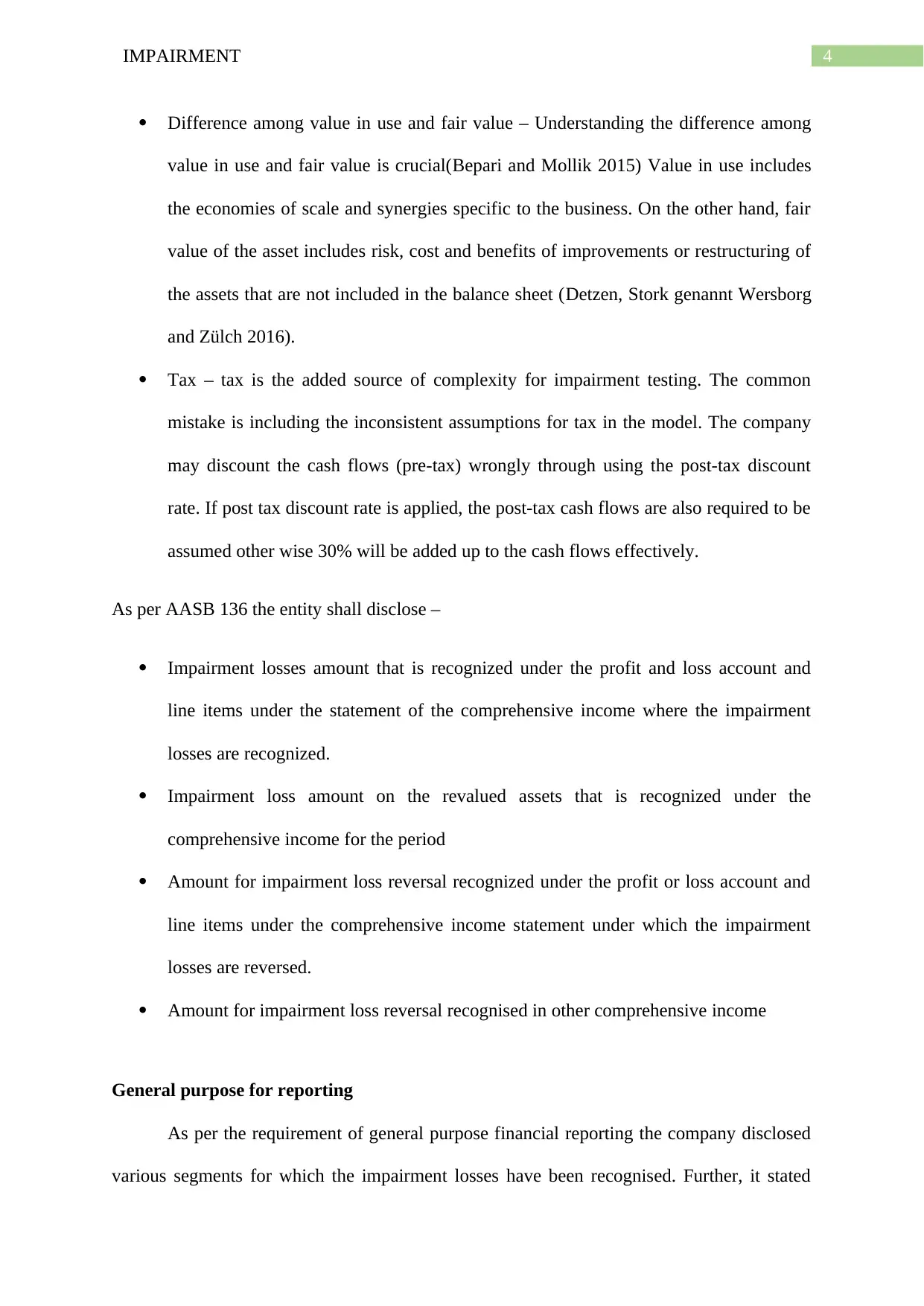
4IMPAIRMENT
Difference among value in use and fair value – Understanding the difference among
value in use and fair value is crucial(Bepari and Mollik 2015) Value in use includes
the economies of scale and synergies specific to the business. On the other hand, fair
value of the asset includes risk, cost and benefits of improvements or restructuring of
the assets that are not included in the balance sheet (Detzen, Stork genannt Wersborg
and Zülch 2016).
Tax – tax is the added source of complexity for impairment testing. The common
mistake is including the inconsistent assumptions for tax in the model. The company
may discount the cash flows (pre-tax) wrongly through using the post-tax discount
rate. If post tax discount rate is applied, the post-tax cash flows are also required to be
assumed other wise 30% will be added up to the cash flows effectively.
As per AASB 136 the entity shall disclose –
Impairment losses amount that is recognized under the profit and loss account and
line items under the statement of the comprehensive income where the impairment
losses are recognized.
Impairment loss amount on the revalued assets that is recognized under the
comprehensive income for the period
Amount for impairment loss reversal recognized under the profit or loss account and
line items under the comprehensive income statement under which the impairment
losses are reversed.
Amount for impairment loss reversal recognised in other comprehensive income
General purpose for reporting
As per the requirement of general purpose financial reporting the company disclosed
various segments for which the impairment losses have been recognised. Further, it stated
Difference among value in use and fair value – Understanding the difference among
value in use and fair value is crucial(Bepari and Mollik 2015) Value in use includes
the economies of scale and synergies specific to the business. On the other hand, fair
value of the asset includes risk, cost and benefits of improvements or restructuring of
the assets that are not included in the balance sheet (Detzen, Stork genannt Wersborg
and Zülch 2016).
Tax – tax is the added source of complexity for impairment testing. The common
mistake is including the inconsistent assumptions for tax in the model. The company
may discount the cash flows (pre-tax) wrongly through using the post-tax discount
rate. If post tax discount rate is applied, the post-tax cash flows are also required to be
assumed other wise 30% will be added up to the cash flows effectively.
As per AASB 136 the entity shall disclose –
Impairment losses amount that is recognized under the profit and loss account and
line items under the statement of the comprehensive income where the impairment
losses are recognized.
Impairment loss amount on the revalued assets that is recognized under the
comprehensive income for the period
Amount for impairment loss reversal recognized under the profit or loss account and
line items under the comprehensive income statement under which the impairment
losses are reversed.
Amount for impairment loss reversal recognised in other comprehensive income
General purpose for reporting
As per the requirement of general purpose financial reporting the company disclosed
various segments for which the impairment losses have been recognised. Further, it stated
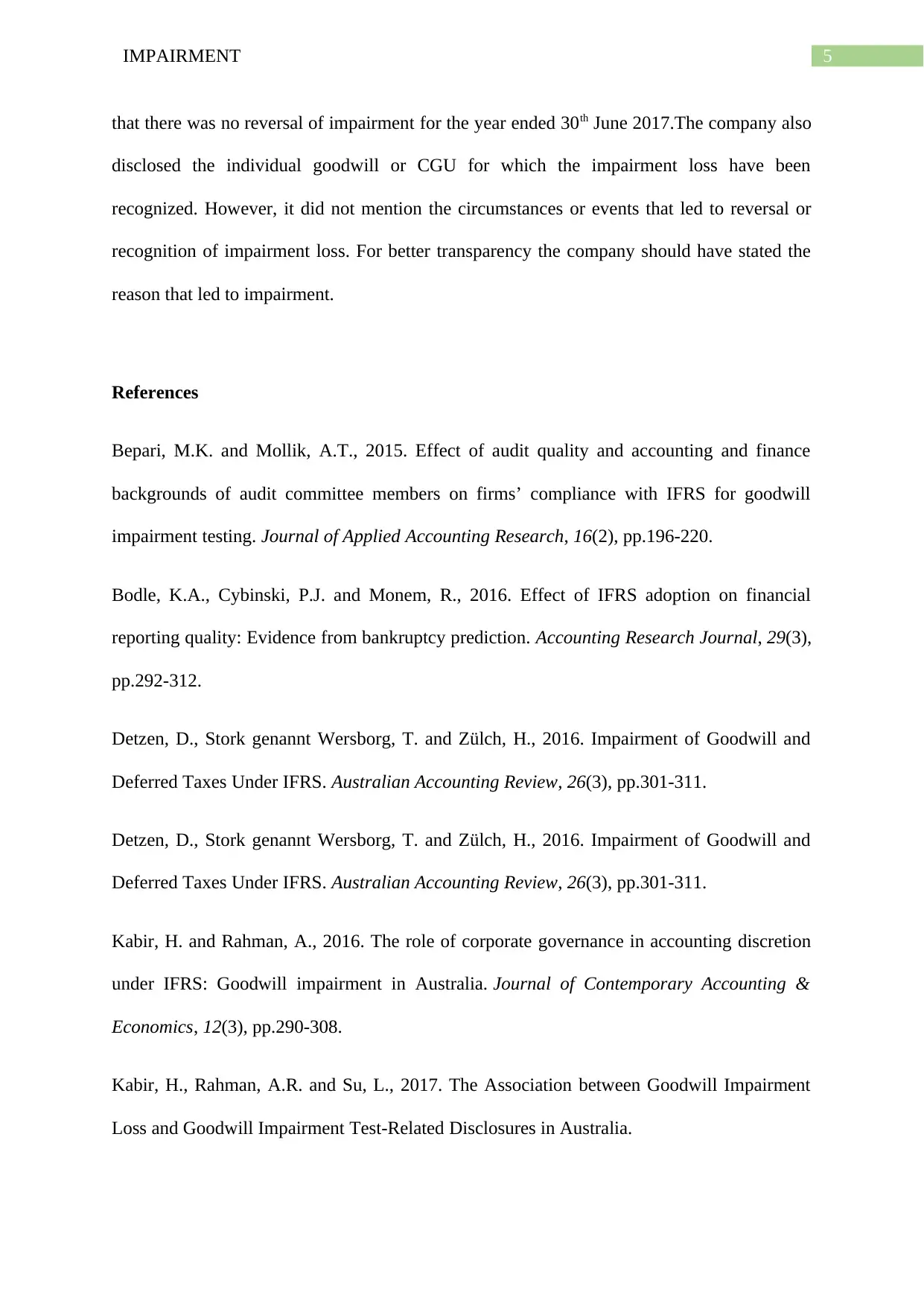
5IMPAIRMENT
that there was no reversal of impairment for the year ended 30th June 2017.The company also
disclosed the individual goodwill or CGU for which the impairment loss have been
recognized. However, it did not mention the circumstances or events that led to reversal or
recognition of impairment loss. For better transparency the company should have stated the
reason that led to impairment.
References
Bepari, M.K. and Mollik, A.T., 2015. Effect of audit quality and accounting and finance
backgrounds of audit committee members on firms’ compliance with IFRS for goodwill
impairment testing. Journal of Applied Accounting Research, 16(2), pp.196-220.
Bodle, K.A., Cybinski, P.J. and Monem, R., 2016. Effect of IFRS adoption on financial
reporting quality: Evidence from bankruptcy prediction. Accounting Research Journal, 29(3),
pp.292-312.
Detzen, D., Stork genannt Wersborg, T. and Zülch, H., 2016. Impairment of Goodwill and
Deferred Taxes Under IFRS. Australian Accounting Review, 26(3), pp.301-311.
Detzen, D., Stork genannt Wersborg, T. and Zülch, H., 2016. Impairment of Goodwill and
Deferred Taxes Under IFRS. Australian Accounting Review, 26(3), pp.301-311.
Kabir, H. and Rahman, A., 2016. The role of corporate governance in accounting discretion
under IFRS: Goodwill impairment in Australia. Journal of Contemporary Accounting &
Economics, 12(3), pp.290-308.
Kabir, H., Rahman, A.R. and Su, L., 2017. The Association between Goodwill Impairment
Loss and Goodwill Impairment Test-Related Disclosures in Australia.
that there was no reversal of impairment for the year ended 30th June 2017.The company also
disclosed the individual goodwill or CGU for which the impairment loss have been
recognized. However, it did not mention the circumstances or events that led to reversal or
recognition of impairment loss. For better transparency the company should have stated the
reason that led to impairment.
References
Bepari, M.K. and Mollik, A.T., 2015. Effect of audit quality and accounting and finance
backgrounds of audit committee members on firms’ compliance with IFRS for goodwill
impairment testing. Journal of Applied Accounting Research, 16(2), pp.196-220.
Bodle, K.A., Cybinski, P.J. and Monem, R., 2016. Effect of IFRS adoption on financial
reporting quality: Evidence from bankruptcy prediction. Accounting Research Journal, 29(3),
pp.292-312.
Detzen, D., Stork genannt Wersborg, T. and Zülch, H., 2016. Impairment of Goodwill and
Deferred Taxes Under IFRS. Australian Accounting Review, 26(3), pp.301-311.
Detzen, D., Stork genannt Wersborg, T. and Zülch, H., 2016. Impairment of Goodwill and
Deferred Taxes Under IFRS. Australian Accounting Review, 26(3), pp.301-311.
Kabir, H. and Rahman, A., 2016. The role of corporate governance in accounting discretion
under IFRS: Goodwill impairment in Australia. Journal of Contemporary Accounting &
Economics, 12(3), pp.290-308.
Kabir, H., Rahman, A.R. and Su, L., 2017. The Association between Goodwill Impairment
Loss and Goodwill Impairment Test-Related Disclosures in Australia.
⊘ This is a preview!⊘
Do you want full access?
Subscribe today to unlock all pages.

Trusted by 1+ million students worldwide
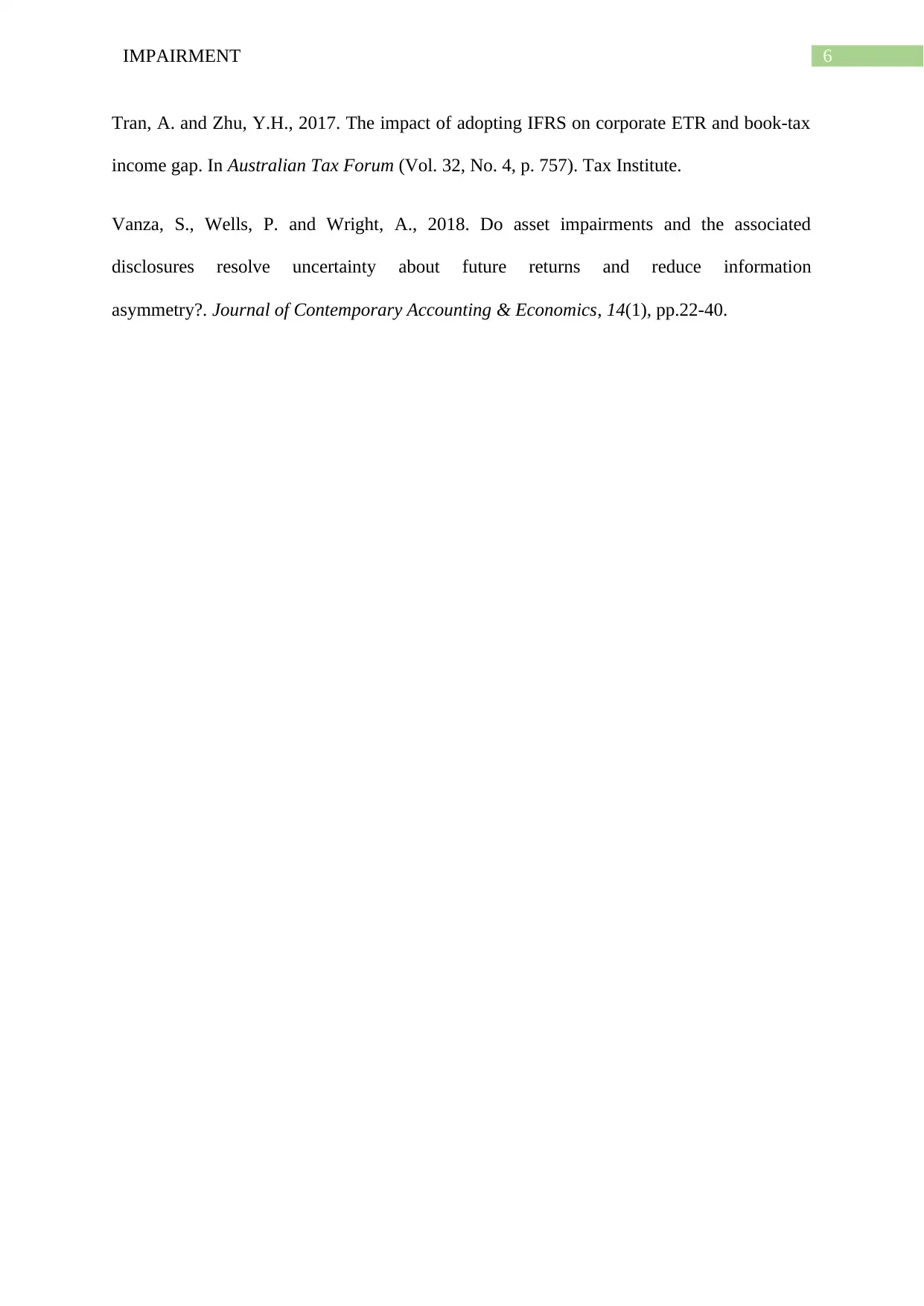
6IMPAIRMENT
Tran, A. and Zhu, Y.H., 2017. The impact of adopting IFRS on corporate ETR and book-tax
income gap. In Australian Tax Forum (Vol. 32, No. 4, p. 757). Tax Institute.
Vanza, S., Wells, P. and Wright, A., 2018. Do asset impairments and the associated
disclosures resolve uncertainty about future returns and reduce information
asymmetry?. Journal of Contemporary Accounting & Economics, 14(1), pp.22-40.
Tran, A. and Zhu, Y.H., 2017. The impact of adopting IFRS on corporate ETR and book-tax
income gap. In Australian Tax Forum (Vol. 32, No. 4, p. 757). Tax Institute.
Vanza, S., Wells, P. and Wright, A., 2018. Do asset impairments and the associated
disclosures resolve uncertainty about future returns and reduce information
asymmetry?. Journal of Contemporary Accounting & Economics, 14(1), pp.22-40.
1 out of 7
Related Documents
Your All-in-One AI-Powered Toolkit for Academic Success.
+13062052269
info@desklib.com
Available 24*7 on WhatsApp / Email
![[object Object]](/_next/static/media/star-bottom.7253800d.svg)
Unlock your academic potential
© 2024 | Zucol Services PVT LTD | All rights reserved.





